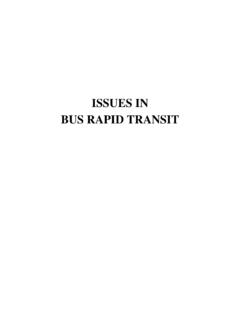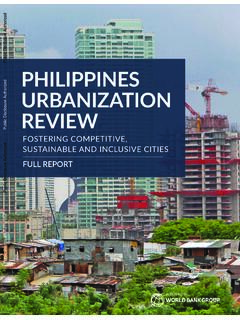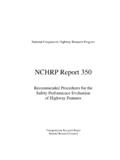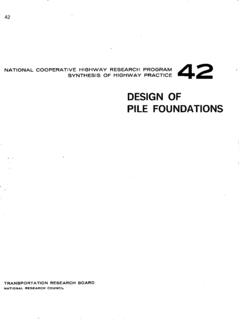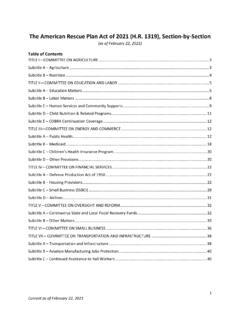Transcription of Connected, Cooperative and Automated Mobility (CCAM)
1 1 | P a g e Draft proposal for a European Partnership under Horizon Europe connected , Cooperative and Automated Mobility (CCAM) Version 13 May 2020 Summary The proposed Partnership aims to harmonise European R&I efforts to accelerate the implementation of innovative CCAM technologies and services. It aims to exploit the full systemic benefits of new Mobility solutions enabled by CCAM: increased safety, reduced environmental impacts, and inclusiveness. By bringing together the actors of the complex cross-sectoral value chain, the Partnership will work on a shared, coherent and long-term R&I agenda. The Vision of the Partnership is: European leadership in safe and sustainable road transport through automation.
2 2 | P a g e About this draft In autumn 2019 the Commission services asked potential partners to further elaborate proposals for the candidate European Partnerships identified during the strategic planning of Horizon Europe. These proposals have been developed by potential partners based on common guidance and template, taking into account the initial concepts developed by the Commission and feedback received from Member States during early consultation1. The Commission Services have guided revisions during drafting to facilitate alignment with the overall EU political ambition and compliance with the criteria for Partnerships.
3 This document is a stable draft of the partnership proposal, released for the purpose of ensuring transparency of information on the current status of preparation (including on the process for developing the Strategic research and Innovation Agenda). As such, it aims to contribute to further collaboration, synergies and alignment between partnership candidates, as well as more broadly with related R&I stakeholders in the EU, and beyond where relevant. This informal document does not reflect the final views of the Commission, nor pre-empt the formal decision-making (comitology or legislative procedure) on the establishment of European Partnerships.
4 In the next steps of preparations, the Commission Services will further assess these proposals against the selection criteria for European Partnerships. The final decision on launching a Partnership will depend on progress in their preparation (incl. compliance with selection criteria) and the formal decisions on European Partnerships (linked with the adoption of Strategic Plan, work programmes, and legislative procedures, depending on the form). Key precondition is the existence of an agreed Strategic research and Innovation Agenda / Roadmap. The launch of a Partnership is also conditional to partners signing up to final, commonly agreed objectives and committing the resources and investments needed from their side to achieve them.
5 The remaining issues will be addressed in the context of the development of the Strategic research and Innovation Agendas/ Roadmaps, and as part of the overall policy (notably in the respective legal frameworks). In particular, it is important that all Partnerships further develop their framework of objectives. All Partnerships need to have a well-developed logical framework with concrete objectives and targets and with a set of Key Performance Indicators to monitor achievement of objectives and the resources that are invested. Aspects related to implementation, programme design, monitoring and evaluation system will be streamlined and harmonised at a later stage across initiatives to ensure compliance with the implementation criteria, comparability across initiatives and to simplify the overall landscape.
6 In case you would like to receive further information about this initiative, please contact: Lead entity (main contact): ERTRAC, Email: Commission services (main contact): DG MOVE, DG R&I, Email: Partnership sector in DG R&I (overall policy approach for European Partnerships and its coherent application across initiatives), Email: 1 3 | P a g e Contents 1 Context, objectives, expected impacts .. 4 Context and problem 4 Common vision, objectives and expected 10 Necessity for a European Partnership .. 18 Partner composition and target group .. 20 2 Planned Implementation.
7 25 Activities .. 25 Implementing the Partnership with CCAM Clusters .. 26 Links with other European Partnerships .. 40 Estimated resources for the CCAM Partnership .. 50 52 Openness and transparency .. 55 4 | P a g e 1 Context, objectives, expected impacts Context and problem definition Mobility is crossing a new digital frontier in terms of connectivity, allowing vehicles to communicate to each other, to the road infrastructure and to other road users. This will enable a coordination and cooperation, managing traffic and Mobility at an entirely new level ( warning messages not limited by line-of-sight or congestion management using real-time information).
8 At the same time, Automated vehicles have a 360 vision of the surrounding environment. Current road vehicles already provide advanced assistance systems and intervene when a dangerous situation is detected. Future systems will have significant reduced reaction times and be able to control the vehicle for extended periods and, at some point in the future, will no longer rely on human back-up. Combining connectivity, Cooperative systems and automation will enable Automated and fully orchestrated manoeuvres, bringing us closer to Vision Zero. Cooperative , connected and Automated Mobility (CCAM) is expected to reshape the way we travel and move, not only in Europe, but around the world.
9 With CCAM, the vehicles are well integrated into the Mobility and transport system, its infrastructure, all operations and new services. In theory, fully Automated driving could double existing average road infrastructure capacity2 by smoothing traffic flow, while enabling off-peak usage of infrastructure for freight transportation ( night-time deliveries). Smart traffic management will further increase efficiency and reduce congestion. CCAM enabled shared Mobility services will enable seamless integration with public transport and Mobility -as-a-Service (MaaS) platforms. It will provide accessible Mobility to people who cannot drive ( incapacitated or disabled people, and those without a driving license), or who no longer want to drive.
10 The goal is to create more user-centred, all-inclusive Mobility , while increasing safety, reducing congestion and contributing to decarbonisation. Automated public transport services will deliver profound changes, not only in how people travel, but also in the way of life. The usage of shared CCAM is expected to bring a tide of benefits, including: flexible, customizable, more widespread and accessible services, reduced noise and air pollution, and better use of urban space, while providing a safer, more comfortable and integrated travel experience. As concerns freight and logistics, the shortage of truck drivers, in particular for the long haul, and the demand for better working conditions requires higher levels of automation that could support further transport productivity3.










